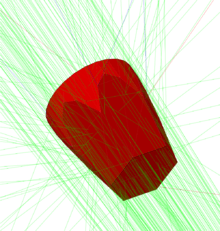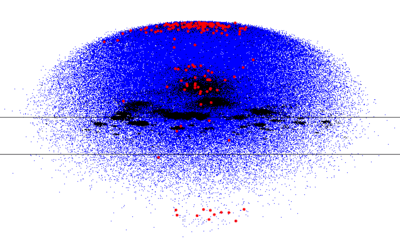Geant4
Geant4[1][2][3][4] (for GEometry ANd Tracking) is a platform for "the simulation of the passage of particles through matter" using Monte Carlo methods. It is the successor of the GEANT series of software toolkits developed by The Geant4 collaboration, and the first to use object oriented programming (in C++). Its development, maintenance and user support are taken care by the international Geant4 Collaboration. Application areas include high energy physics and nuclear experiments, medical, accelerator and space physics studies.[3] The software is used by a number of research projects around the world.
| Developer(s) | Geant4 Collaboration |
|---|---|
| Initial release | 1998[1] |
| Stable release | 10.6
/ December 6, 2019 |
| Repository | |
| Operating system | Cross-platform |
| Type | Computational physics |
| License | Geant4 Software License |
| Website | geant4 |

The Geant4 software and source code is freely available from the project web site; until version 8.1 (released June 30, 2006), no specific software license for its use existed; Geant4 is now provided under the Geant4 Software License.
Features
Geant4 includes facilities for handling geometry, tracking, detector response, run management, visualization and user interface. For many physics simulations, this means less time needs to be spent on the low level details, and researchers can start immediately on the more important aspects of the simulation.
Following is a summary of each of the facilities listed above:
- Geometry is an analysis of the physical layout of the experiment, including detectors, absorbers, etc., and considering how this layout will affect the path of particles in the experiment.
- Tracking is simulating the passage of a particle through matter. This involves considering possible interactions and decay processes.
- Detector response is recording when a particle passes through the volume of a detector, and approximating how a real detector would respond.
- Run management is recording the details of each run (a set of events), as well as setting up the experiment in different configurations between runs.
- Geant4 offers a number of options for visualization, including OpenGL, and a familiar user interface, based on Tcsh.
Geant4 can also perform basic histogramming; it requires external analysis tools or software that implements the AIDA framework for exploiting advanced histogramming features.
Since release 10.0, Geant4 implements multithreading,[4] making use of thread-local storage to allow for efficient generation of simulated events in parallel. GEANT4 can be installed under a Unix-based operating system such as MacOS or Linux or under Windows.
Some high energy physics experiments using Geant4
Applications outside high energy physics

Because of its general purpose nature, Geant4 is well suited for development of computational tools for analysing interactions of particle with matter in many areas. These include:
- Space applications where it is used to study interactions between the natural space radiation environment and space hardware or astronauts;
- Medical applications where interactions of radiations used for treatment are simulated.
- Radiation effects in microelectronics where ionizing effects on semiconductor devices are modeled.
- Nuclear physics
See also
References
- Agostinelli, S.; Allison, J.; Amako, K.; Apostolakis, J.; Araujo, H.; Arce, P.; Asai, M.; Axen, D.; Banerjee, S.; Barrand, G.; Behner, F.; Bellagamba, L.; Boudreau, J.; Broglia, L.; Brunengo, A.; et al. (2003). "Geant4—a simulation toolkit". Nuclear Instruments and Methods in Physics Research Section A: Accelerators, Spectrometers, Detectors and Associated Equipment. 506 (3): 250. Bibcode:2003NIMPA.506..250A. doi:10.1016/S0168-9002(03)01368-8.
- Allison, J.; Amako, K.; Apostolakis, J.; Arce, P.; Asai, M.; Aso, T.; Bagli, E.; Bagulya, A.; Banerjee, S.; Barrand, G.; Beck, B.R.; Bogdanov, A.G.; Brandt, D.; Brown, J.M.C.; Burkhardt, H.; Canal, Ph.; Cano-Ott, D.; Chauvie, S.; Cho, K.; Cirrone, G.A.P.; Cooperman, G.; Cortés-Giraldo, M.A.; Cosmo, G.; Cuttone, G.; Depaola, G.; Desorgher, L.; Dong, X.; Dotti, A.; Elvira, V.D.; Folger, G.; Francis, Z.; Galoyan, A.; Garnier, L.; Gayer, M.; Genser, K.L.; Grichine, V.M.; Guatelli, S.; Guèye, P.; Gumplinger, P.; Howard, A.S.; Hřivnáčová, I.; Hwang, S.; Incerti, S.; Ivanchenko, A.; Ivanchenko, V.N.; Jones, F.W.; Jun, S.Y.; Kaitaniemi, P.; Karakatsanis, N.; Karamitros, M.; Kelsey, M.; Kimura, A.; Koi, T.; Kurashige, H.; Lechner, A.; Lee, S.B.; Longo, F.; Maire, M.; Mancusi, D.; Mantero, A.; Mendoza, E.; Morgan, B.; Murakami, K.; Nikitina, T.; Pandola, L.; Paprocki, P.; Perl, J.; Petrović, I.; Pia, M.G.; Pokorski, W.; Quesada, J.M.; Raine, M.; Reis, M.A.; Ribon, A.; Ristić Fira, A.; Romano, F.; Russo, G.; Santin, G.; Sasaki, T.; Sawkey, D.; Shin, J.I.; Strakovsky, I.I.; Taborda, A.; Tanaka, S.; Tomé, B.; Toshito, T.; Tran, H.N.; Truscott, P.R.; Urban, L.; Uzhinsky, V.; Verbeke, J.M.; Verderi, M.; Wendt, B.L.; Wenzel, H.; Wright, D.H.; Wright, D.M.; Yamashita, T.; Yarba, J.; Yoshida, H. (2016). "Recent developments in G eant 4". Nuclear Instruments and Methods in Physics Research Section A: Accelerators, Spectrometers, Detectors and Associated Equipment. 835: 186–225. Bibcode:2016NIMPA.835..186A. doi:10.1016/j.nima.2016.06.125. ISSN 0168-9002.
- Allison, J.; Amako, K.; Apostolakis, J.; Araujo, H.; Arce Dubois, P.; Asai, M.; Barrand, G.; Capra, R.; Chauvie, S.; Chytracek, R.; Cirrone, G.A.P.; Cooperman, G.; Cosmo, G.; Cuttone, G.; Daquino, G.G.; et al. (2006). "Geant4 developments and applications" (PDF). IEEE Transactions on Nuclear Science. 53 (1): 270–278. Bibcode:2006ITNS...53..270A. doi:10.1109/TNS.2006.869826. hdl:2047/d20000660.
- Allison, J.; Amako, K.; Apostolakis, J.; Arce, P.; Asai, M.; Aso, T.; Bagli, E.; Bagulya, A.; Banerjee, S.; Barrand, G.; Beck, B.R.; Bogdanov, A.G.; Brandt, D.; Brown, J.M.C.; Burkhardt, H.; et al. (2016). "Recent developments in Geant4". Nuclear Instruments and Methods in Physics Research Section A: Accelerators, Spectrometers, Detectors and Associated Equipment. 835: 186–225. Bibcode:2016NIMPA.835..186A. doi:10.1016/j.nima.2016.06.125.